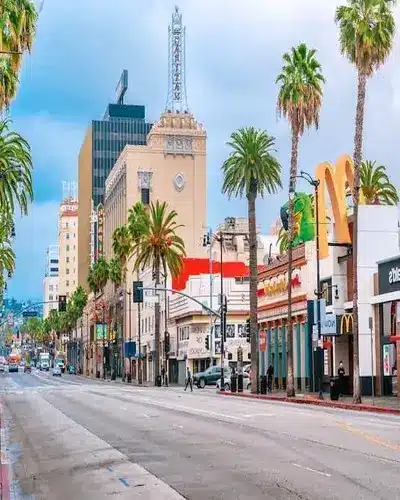
Los Angeles history facts
Los Angeles City site
The city of Los Angeles is composed of a series of widely dispersed settlements that are loosely connected to the city. This is certainly not consistent with the popular Chicago School of Urban Theory of the 1920s and beyond, which held that downtown was the central center of community life, with influence manifesting in a series of concentric circles in the hinterland.
Apart from those who work there, the vast majority of Angelenos have little connection to the city in their daily lives and are content to work, shop, and entertain in the suburbs that stretch out in all directions.
Table of Contents
Outer districts located within the city limits include Hollywood, northwest of the city; Encino, Van Nuys, and North Hollywood in the San Fernando Valley; Century City, Westwood, and Venice on the West Side; San Pedro and Wilmington in the port area; And Boyle Heights is just east of the river. Some new remote communities, such as Warner Center, look like self-contained small towns.
The main link connecting the city and suburbs is the famous Los Angeles Freeway, which stretches across the region in a vast network of concrete ribbons. A drive in any direction offers a variety of landscapes. Some roads cross the Los Angeles River, which appears to be a massive, cement-lined flood-control channel.
The mountains and their steep-walled valleys are dotted with bushes, grass and the occasional house. Motorists get a glimpse of some dramatic scenes; For example, a nighttime view of the San Fernando Valley from Mulholland Peak on the San Diego Freeway.
However, in general, there is little to distinguish one community from another when viewed from the freeways. Cars and trucks move in solid masses, moving continuously at rooftop level through one-story residential areas, shopping strips and malls.
There is not a single manufacturing sector in Los Angeles. The typical industrial installation is located in a one-story building next to a large parking lot and can be found along a rail line or near a major road or freeway, accessible by huge trucks. All this explains why author Dorothy Parker once described Los Angeles as “seventy-two suburbs looking for a city.”
Anyone familiar with a city like Chicago and its grid-based street pattern could reasonably assume that Los Angeles was never planned. The English architectural creator Reyner Banham referred to as making plans in l. a. “a self-canceling idea”. Yet Spanish colonists founded the original pueblo in 1781 according to a plan laid out in 16th-century Laws of the Indies,
and the county subsequently maintained a general grid of outbuildings, streets, and highways. An imaginative and comprehensive regional planning proposal to preserve open space, completed in 1924 by the planning firm headed by Frederick Law Olmsted, Jr.,
did enough to slow the powerful trend of urban sprawl and preference for the automobile. Failed to garner support. Nevertheless, original designs of small planned communities in outlying areas such as Westwood and Palos Verdes Estates have won praise.
Downtown Los Angeles draws hundreds of thousands of Angelenos to its government and commercial offices and its cultural facilities. Its specific subdistricts are Civic Center, Music Center, Spring Street, Broadway, Chinatown, Olvera Street, Little Tokyo, Library Square, and Staples Center.
Although these areas are crowded during weekdays, most are almost deserted in the evening. Bunker Hill overall contains some of the tallest, newest, and grandest buildings in the city.
Downtown never had many factories and most of its major department stores, theaters, restaurants, and residences were destroyed during the construction of freeways; Its inhabitants are also relatively less. However, wholesale markets for clothing, jewelry, toys, furniture, flowers and produce are among the busiest enterprises in Southern California.
Since the 1980s, the city has taken significant steps to redevelop the city by increasing the housing stock, accommodating new recreational and cultural activities, and inviting pedestrian activity. Loft conversions have created new condominium living spaces.
The river is seen as a major recreational asset. Downtown’s greatest shortcomings are its large Skid Row area (sometimes called Central City East) and its lack of housing for middle- and low-income families and the shops and amenities conducive to life at street level.
Read more- QR CODE GENERATOR TOOL 100% FREE
Google Adsense approval Tricks & tips 2023
How much is it to buy the New York Jets?
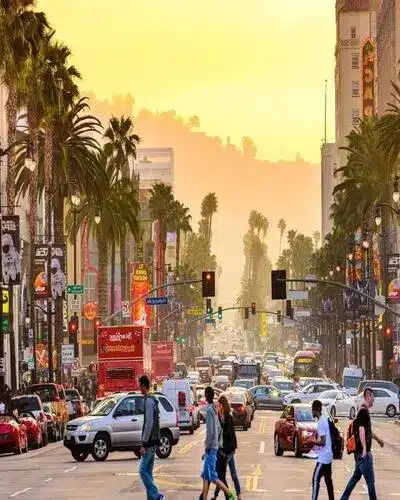
Economy of Los Angeles
Southern California’s regional economy is large, diverse, and in constant flux. Agriculture became important after the first citrus orchards were planted by Spanish missionaries in the 1700s. Manufacturing has also been important.
The county has a wide range of financial and business services, high-technology manufacturing, and craft and fashion industries such as jewellery, clothing, toys, music and, most famously, films. If the Los Angeles metropolitan area were a country, its gross national product would exceed that of all but a few of the world’s most prosperous countries.
After an extended duration of growth within the twentieth century, the neighborhood financial system skilled a recession within the 1990s. A strong recovery began in the middle of the decade and the economy showed considerable resilience, especially in the high-tech sector. By the turn of the century the fastest growing sectors for employment were construction, transportation, public utilities, finance, insurance, real estate, and government services.
The global economy has created striking undercurrents in regional job markets since the 1980s. As less-profitable manufacturing plants have closed or moved to other countries, higher-paying and more labor-intensive jobs have declined and lower-paying jobs have increased. Local employers are becoming increasingly dependent on immigrant workers. Sweatshop conditions exist in some clothing manufacturing and other low-wage industries.
From the 1930s to the 1950s, the labor movement gained considerable strength in the auto, aircraft, movie, trucking, longshoring, and food handling industries. Then, after a gradual decline in membership in those activities, unions organized teachers, nurses, and other service workers.
The gains continued into the 1990s and early 21st century, when the AFL-CIO embraced immigrant workers (particularly those in janitorial and hotel work), pursued a policy of living wage for city workers, and Played an active role in local politics.
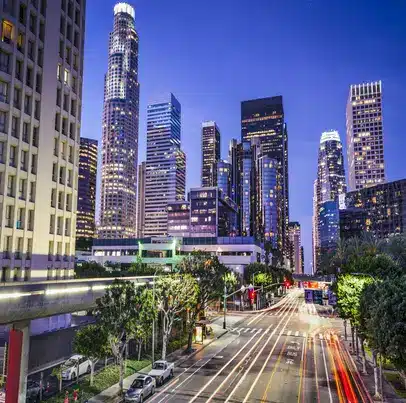
Finance and other services
Commercial enterprise and expert control offerings, fitness services, and research and finance are important, as are exchange and tourism. the majority of the group of workers is now hired in offerings which includes retail, eating places and motels, authorities organizations, and faculties and faculties. The unmarried largest personal agency in the town is the college of Southern California (USC).
Supermarkets, regional shopping malls, and retail strip malls are aspects of retail commerce that are closely associated with Los Angeles, especially in the era of the automobile and associated suburban expansion.
When the city extended Wilshire Boulevard from downtown to Santa Monica Beach in the 1920s and 30s, the street became the first major shopping artery to cater exclusively to customers arriving by car. The primary local mall used to be the Crenshaw buying center (now referred to as 1st earl baldwin of bewdley Hills Crenshaw Plaza), which opened in 1947.
Suburban retail expansion came at the expense of the city’s department stores, but the city still has Broadway, where most of the Latino working class comes from. Family and is the busiest retail street west of downtown Chicago. Because of its trade ties with countries in Latin America, Asia, and the Pacific Ocean, Los Angeles is now considered by some to be the crossroads of the Pacific Rim.
More than 85 countries maintain trade commissions in Los Angeles, while the Los Angeles Convention Center hosts major trade shows for national marketers of cars, electronic gear, high-tech products, Motorcycles, pride boats and recreational vehicles, amongst other merchandise.
Los Angeles became a major financial center in the early 20th century, with strong activity in oil drilling, agriculture, and land development. A major milestone was achieved in 1920, when Los Angeles’ bank clearing exceeded that of San Francisco.
In subsequent decades more than a billion shares were traded annually on the Pacific Stock Exchange. That institution closed its Los Angeles offices in 2001, redirecting local investors to electronic trading on the New York Stock Exchange.
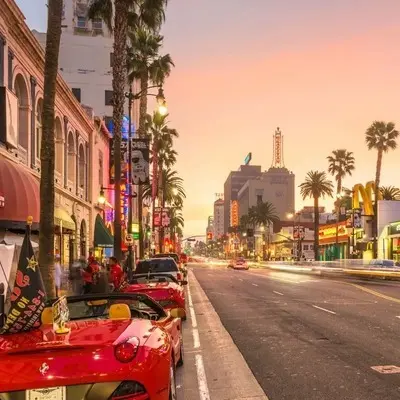
los angeles history facts
Historically, the areas of present-day Los Angeles were home to the Chumash and Tongva Native American tribes. On September 4, 1781, a group of settlers consisting of 14 families, including 44 people of Native American, African, and European heritage, traveled more than a thousand miles across the desert from present-day northern Mexico and established a settlement in the region.
Established farming community. “El Pueblo de Nuestra Señora la Reina de los Ángeles de Porciuncula” which translates to “The Town of Our Lady the Queen of the Angels of Porciuncula” in English. Over time the community grew under the flags of Spain, Mexico, and eventually the United States to become the city of Los Angeles, one of the largest metropolitan cities in the world.
Today, the original pueblo is celebrated as a Los Angeles historical monument. El Pueblo de Los Angeles Historical Monument is a living museum that continues to fulfill its unique role as the historical and symbolic heart of the city, Spanning Native American, African American, Spanish, Anglo, Mexican, Chinese, Italian, and French cultures.
It reflects. Contributed to its early history. Eleven of the monument’s twenty-seven historic buildings are open to the public as businesses or have been restored as museums.
The official seal for the City of Los Angeles was designed by Herbert L. Goudge, a deputy city attorney, and officially adopted through Ordinance 10,834 on March 27, 1905.
The coat of arms in the center of the seal displays 4 different images representing 4 different phases of Los Angeles history;
The first quarter displays the stars and stripes of the American flag denoting its status as a city in the United States since 1848.
The second quarter features the grizzly bear flag of California reflecting its history as part of the Republic of California from 1846 to 1848.
The third quarter depicts the eagle holding a snake from the coat of arms of Mexico which is the symbol of Mexican rule from 1822 to 1846.
The fourth quarter depicts Castile and León from the coat of arms of Spain, reflecting Spanish colonial rule from 1542 to 1821.
The coat of arms is surrounded by images of olives, grapes and oranges, which historically represent the 3 major crops of Los Angeles. The fruits are surrounded by a rosary of 77 beads representing the role played by Spanish missions in the early years of Los Angeles.
The unique flag of the town of LA was designed in 1931. Ordinance 70,000 officially established the city’s own flag on July 22, 1931, known as the “Fiesta Flag”, which was designed for the city’s 150th birthday (sesquicentennial).
The 8′ x 12′ banner features a taffeta background of red, gold yellow and green notched stripes. Red denotes vineyards, golden-yellow denotes orange groves, and green denotes olive groves. The flag’s colors are also found in the flags of Spain and Mexico, whose pasts were very important in the early history of Los Angeles. A replica of the city seal is shown in the center of the flag.
The flag was designed by Roy E. Silent and E.S. Was designed by. Jones of Los Angeles. The flag was raised in April 1937, eighty-seven years after the city’s incorporation. La Fiesta Association President Isadore B. The flag was presented by Dockweiler to Mayor Frank E. Shaw.
Transportation of Los Angeles
Automobile-established la has struggled to create a balanced mass transit machine. It once boasted the Pacific Electric Railway (PE), a privately owned trolley system built in the early 20th century by real estate and railroad mogul Henry E. Huntington.
He saw PE primarily as a vehicle for real estate development, and constantly lost money in rent boxes. Over time, PE’s “big red cars”, running on fixed tracks, could not compete with automobiles for ease of navigating in the suburbs, and they increasingly became the cause of traffic jams and collisions on city streets.
PE management ignored repeated demands from reformers for system-wide reforms, while suburban taxpayers rejected proposals for public procurement. The railroad gradually dismantled its lines and the last Red Car ran in 1961.
By the late 1940s, Angelenos regarded cars and freeways as a necessity. Although these high-speed, multilane, limited-access highways were developed elsewhere, they reached their full development in Los Angeles. The prototype Arroyo Seco Parkway (Pasadena Freeway) opened on the last day of 1939 to carry revelers to New Year’s celebrations in Pasadena.
The more modern Hollywood Freeway (completed in 1948) soon carried some 200,000 cars a day, leading comedian Bob Hope to call it “the world’s largest parking lot.” The four-level downtown freeway “stack” became the most familiar symbol of the city’s built environment.
Freeway construction boomed thereafter and by the 1970s the system was largely dismantled. Although these streets integrated and defined the physical structure of Los Angeles, their ever-increasing traffic – coupled with increased pollution causing delays and smog – led to renewed interest in public transportation.
Los Angeles voters rejected several proposals before approving a plan for a new system that would build several light-rail lines and a subway, in addition to improving a deteriorating bus system. The state followed suit in 1993 by creating the Los Angeles County Metropolitan Transportation Authority (MTA) to build and operate such a system.
Work started slowly due to tunnel collapses in Hollywood and funding delays, but by the beginning of the 21st century the MTA had completed a subway between Union Station downtown and North Hollywood and several light-rail lines.
Additional metro and rail lines were planned or under construction. In addition to its regular city bus service, the MTA also operates transitway buses (which follow dedicated bus roads, thus avoiding traffic problems) and Metro Rapid Express bus service in several corridors across the city.
Los Angeles and neighboring counties are also served by a series of shuttle and other municipal bus lines. A separate regional commuter rail service, Metrolink, opened in 1992 and has grown into a network of lines connecting Los Angeles, Ventura, San Bernardino, Riverside, Orange, and San Diego counties.
Los Angeles is served by interstate buses and Amtrak intercity passenger rail service, but air travel is by far the most important transportation link outside the region. Los Angeles International Airport (popularly called by its international code, LAX) is one of the largest airports in the world, handling millions of passengers and millions of tons of cargo annually. Traffic at LAX continues to grow, but proposals to expand the facility are facing strong opposition in surrounding communities.
At the beginning of the 21st century, the combined ports of Los Angeles and Long Beach handled approximately two-thirds of the West Coast’s foreign import cargo and, in terms of volume, was jointly the world’s third-largest port, behind Singapore and Hong Kong.
Main imports included automobiles, gasoline and jet fuel, steel, shoes, lumber, scrap metal, copper ore, and inorganic compounds. Ports provided thousands of jobs and generated considerable tax revenue.
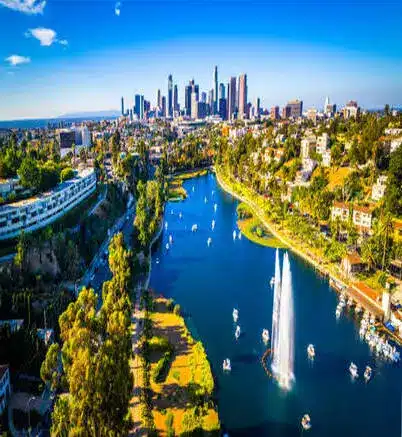
Economy of Los Angeles
Southern California’s regional economy is large, diverse, and in constant flux. Agriculture became important after the first citrus orchards were planted by Spanish missionaries in the 1700s. Manufacturing has also been important.
The county has a wide range of financial and business services, high-technology manufacturing, and craft and fashion industries such as jewellery, clothing, toys, music and, most famously, films. If the Los Angeles metropolitan area were a country, its gross national product would exceed that of all but a few of the world’s most prosperous countries.
After an extended duration of increase inside the twentieth century, the nearby financial system experienced a recession in the 1990s. A strong recovery began in the middle of the decade and the economy showed considerable resilience, especially in the high-tech sector.
By the turn of the century the fastest growing sectors for employment were construction, transportation, public utilities, finance, insurance, real estate, and government services.
The global economy has created striking undercurrents in regional job markets since the 1980s. As less-profitable manufacturing plants have closed or moved to other countries, higher-paying and more labor-intensive jobs have declined and lower-paying jobs have increased.
Local employers are becoming increasingly dependent on immigrant workers. Sweatshop conditions exist in a few clothing manufacturing and other low-salary industries.
From the 1930s to the 1950s, the labor movement gained considerable strength in the auto, aircraft, movie, trucking, longshoring, and food handling industries. Then, after a gradual decline in membership in those activities, unions organized teachers, nurses, and other service workers.
The gains continued into the 1990s and early 21st century, when the AFL-CIO embraced immigrant workers (particularly those in janitorial and hotel work), pursued a policy of living wage for city workers, and Played an active role in local politics.